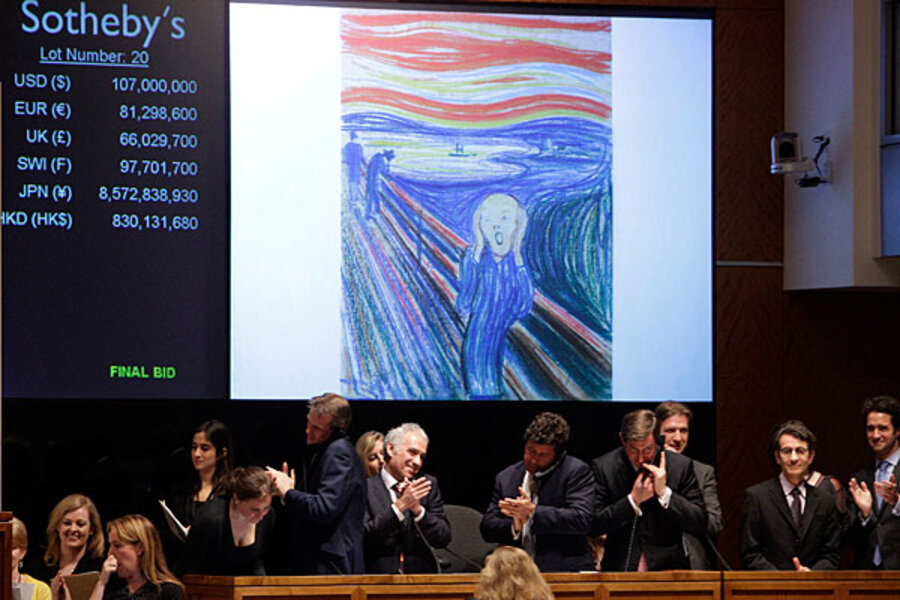The Scream sale led to record $330 million auction at Sotheby's
Loading...
| New York
Edvard Munch's masterpiece "The Scream," one of the world's most recognizable works of art, sold for $120 million at Sotheby's on Wednesday, setting a new record as the most expensive piece of art ever sold at auction.
Sotheby's Impressionist and Modern art auction featured top works by Picasso, Dali and Miro, but Munch's vibrant work from 1895 was the star attraction in a salesroom packed with art collectors, dealers and media.
The vibrant pastel was conservatively estimated to sell for about $80 million, but two determined bidders competing via telephone emerged from an initial group of seven, driving the final price to $107 million, or $119,922,500 including commission, over the course of a nearly 15-minute bidding war.
IN PICTURES: The world's most expensive art
The winning bid was taken by a Sotheby's executive, and the bidder was not identified.
One of four versions by the Scandinavian painter, sold by Norwegian businessman Petter Olsen, "The Scream" easily eclipsed the old auction record held by Picasso's "Nude, green leaves and bust," which sold for $106.5 million at Christie's two years ago.
The sales room at Sotheby's erupted in applause and cheering when the hammer came down. Several Sotheby's officials said the sale marked the high point of their careers.
"It's worth every penny that the collector paid," said Tobias Meyer, who served as auctioneer and called it "one of the great icons" of fine art.
In recent decades "The Scream," which depicts a figure with hands pressed to head against a backdrop of swirling colors, has become a ubiquitous image, appropriated for everything from coffee mugs to editorial cartoons.
For many mainstream art lovers, it is perhaps second in familiarity only to the "Mona Lisa," and is among the best-known works of art still in private hands.
Sotheby's New York head of Impressionist and Modern art Simon Shaw called it "one of the visual keys to modern consciousness," adding that it was "perhaps the greatest single draw I've seen in my career" at the auction house.
80 PERCENT OF LOTS FIND BUYERS
Three other images of "The Scream," including two which were stolen and later recovered, are in museums in Norway.
Overall, the sale brought in $330.6 million, against an estimate of about $245 million to $325 million, and 80 percent of the 76 lots on offer found buyers.
The total was Sotheby's highest-ever for an Impressionist and Modern auction, beating the old mark of $286 million, which had stood since 1990. It was also the auction house's second-best evening in its history.
Other highlights included Picasso's "Femme assise dans un fauteuil," which sold for $29.2 million; Miro's "Tete humaine" went for $14.86 million; and Dali's "Printemps necrophilique," which fetched $16.3 million, or about 50 percent more than the pre-sale estimate.
Works by Max Ernst, Tamara de Lempicka, Constantin Brancusi and Paul Gauguin all achieved strong prices, many far exceeding their high estimates.
The collection of financier Ted Forstmann took in $83 million, meeting expectations, although works by Chaim Soutine that were considered highlights failed to make their estimates.
But in the end it was all about the Munch. Olsen, who attended the sale, said afterward he hoped the stunning results would help drive interest in Munch's work, and added that the artist "will be a continuing force in my life."
Speaking to its enduring topical nature and present-day relevance, Olsen said "The image of 'The Scream' could make more of us fathom the magnitude of the consequences of our continuing emissions of greenhouse gases."
"For me, (it) shows the horrifying moment when man realizes his impact on nature and the irreversible changes that he has initiated, making the planet increasingly uninhabitable."
Several other works by Munch in the sale failed to achieve a coattail effect, selling for less than their low estimates and in one case, not at all.
The art auctions continue next week when both Sotheby's and Christie's hold their sales of Post-war and Contemporary art. (Editing by Lisa Shumaker and Todd Eastham)







